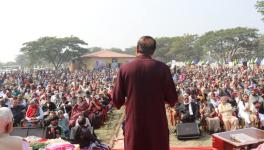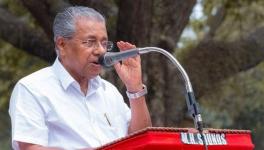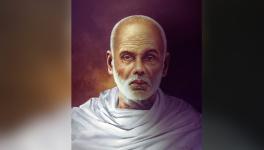TN: M K Stalin, Pinarayi Vijayan Slam ‘Sanatana Dharma’ Promoted by Sangh on 200th year of Chhanar Revolt
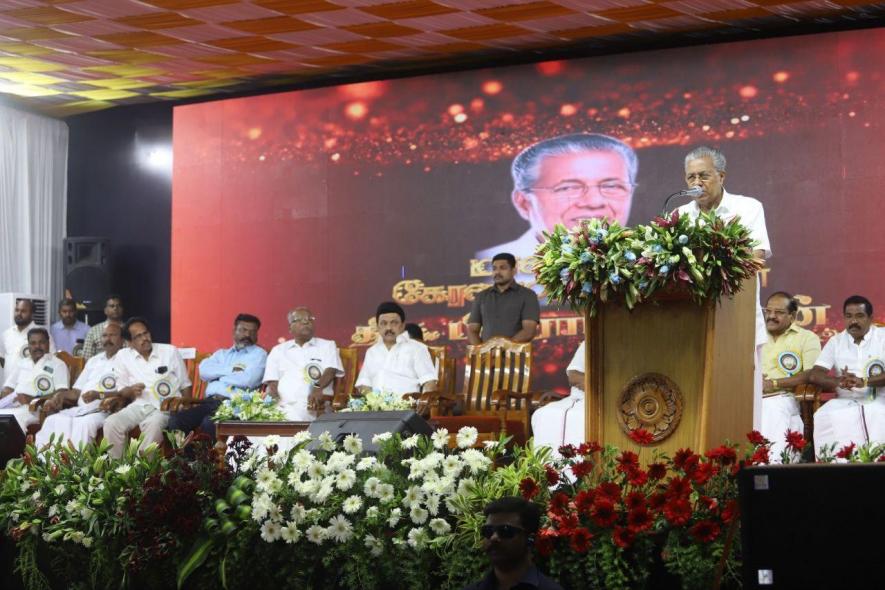
Pinarayi Vijayan addressing a public meeting in Nagercoil commemorating the Channar Revolt. (Credit: J Jessin)
Kanyakumari: The Chief Ministers of Kerala and Tamil Nadu, Pinarayi Vijayan and M K Stalin, on Monday called upon people to defeat rightwing forces hailing the “divisive” Sanatana Dharma. Addressing a massive gathering at Nagercoil in Kanniyakumari district, they stressed the importance of defeating such forces that they said perpetuate caste-based discrimination.
The meeting was held to commemorate the 200th anniversary of the ‘Channar Revolt’ or Upper Cloth Movement, which took place in the princely state of Travancore (present-day Kerala) during the 1800s. About 18 caste groups were categorised as 'Avarnas' by the Travancore Kingdom at the time. A social uprising was led by Nadar women for the right to cover their upper body; only dominant caste women had the right to cover their upper body.
Sending a political message, the two chief ministers called upon “democratic forces” to unite to fight the general elections and end the Bharatiya Janata Party’s rule, which they said was destroying the secular and federal principles of India.
‘SANATANA RULE IN TRAVANCORE’
The cruel practices of untouchability escalated in the 1750s, when the king of the princely state of Travancore, Marthanda Varma, announced to be ‘Padmanaba Dasan’ (Servant of Lord Padhmanaba) and the implementation of ‘Sanatana Dharma’ as the rule book for the nation.
Eighteen caste groups were denied permission to cover their upper bodies, sport moustaches, wear ornaments, receive education, walk through the streets of upper castes, and access drinking water wells, among other untouchability practices.
A V Bellarmin, former member of parliament from the Communist Party of India (Marxist) [CPI(M)] and the convenor of the public meeting, told NewsClick that the implementation of the Sanatana Dharma divided people into Savarna and Avarna.
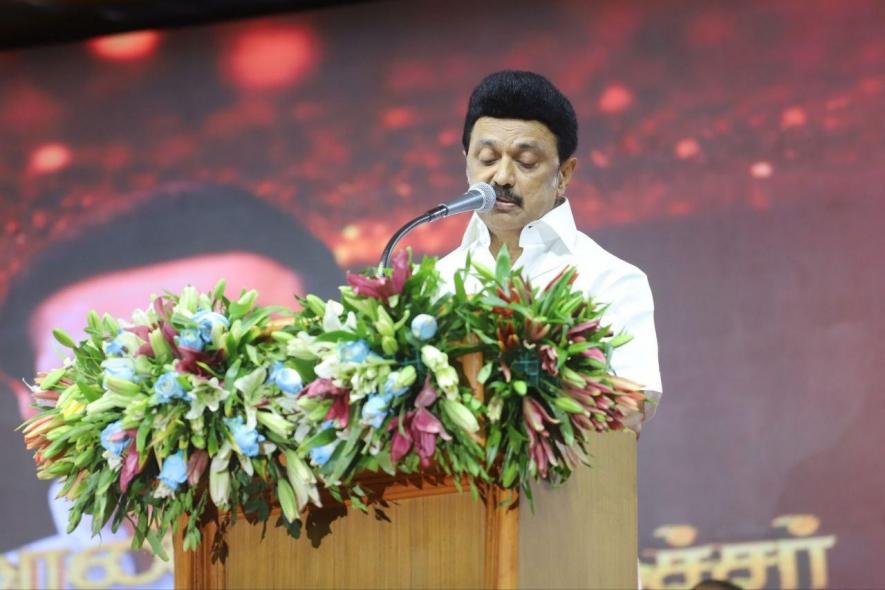
Tamil Nadu Chief Minister M K Stalin addressing the meeting. (Credit: J Jessin)
“Majority of the working class people were categorised as Avarnas and were denied several basic rights. The kingdom governed by Sanatana Dharma did not permit them to use footwear, use umbrellas; besides, it implemented slavery and they could be sold or mortgaged,” he said.
Another cruel practice that prevailed during the period was the ‘breast tax’ on women from the 18 Avarna caste groups, including Nadars and Ezhavas. The death of ‘Nangeli’, after she cut off her breasts in protest of the tax, intensified the agitations against the cruel practice and became the foundation of the ‘Thol Seelai Porattam’ (in Tamil) or ‘Mel Mundu Samaram’ (in Malayalam).
Historians had recorded several dehumanising practices, including an incident when a pregnant woman was tied along with a bull to plough the field after she turned up late for work. Unpaid work for the kingdom was another rule implemented by the Sanatana Dharma.
INTENSIFIED STRUGGLES SINCE 1822
The arrival of missionaries to the western coastal areas brought changes among the people since they were provided education leading to the affected people converting to Christianity. The women who converted to Christianity were permitted to wear upper clothes, but not the ones similar to the upper caste women.
Those who converted and visited churches were also attacked mercilessly by the henchmen of the king, leading to riots in several parts of Travancore when churches were burnt.
“The struggle began in 1822-23, and extended until 1859. The role of missionaries and Ayya Vaikundar played an important role in bringing an end to the cruel practices which prevailed in the Travancore state,” Bellarmin said.
He said Ayya Vaikundar propagated unity of all castes and called for ‘Samathuva Samajam’ (Egalitarian Society) in the 1820s. A drinking water well was dug in Swamithoppu, the headquarters of the ‘Ayya Vazhi’, for all caste groups without discrimination.
After the sustained struggles, the women of all castes were permitted to wear upper clothes by the Travancore Princely state on July 26, 1859 as per the orders of the Ayilyam Thirunal Marthanda Varma.
The recent statements by several members and supporters of the BJP and RSS of Sanatana Dharma being the best suited for the country has led to several protests and agitations, and this commemoration of the historic Channar Revolt by the CPI(M), Dravida Munnetra Kazhagam (DMK) and other secular progressive parties.
‘SANATANA DHARMA IS A THREAT TO HUMANITY’
Vijayan and Stalin told the public that the right-wing forces’ claims about the Sanatana Dharma were misleading.
Meanwhile, the governor of Tamil Nadu has been making claims about the beauty of Sanatana Dharma and its supposed inclusivity, triggering backlashes from the parties in the state.
While addressing the meeting, Vijayan said, “The BJP is attempting to divide the people on religious grounds for electoral gains. They are aggressively pushing Sanatana Dharma as the solution for all the problems. But the history of the Channar revolt exposes the cruel practices of the so-called dharma.”
He noted the contributions of Ayyankali, Ayya Vaikundar, Sree Narayanaguru, ‘Periyar’ E V Ramasamy in bringing social reforms against Sanatana Dharma, which he said imposed division among people based on caste.
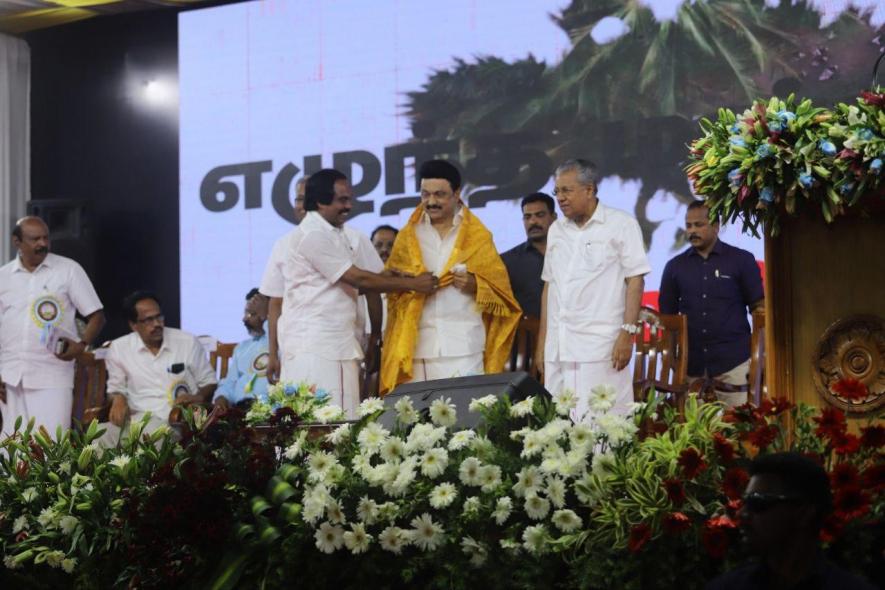
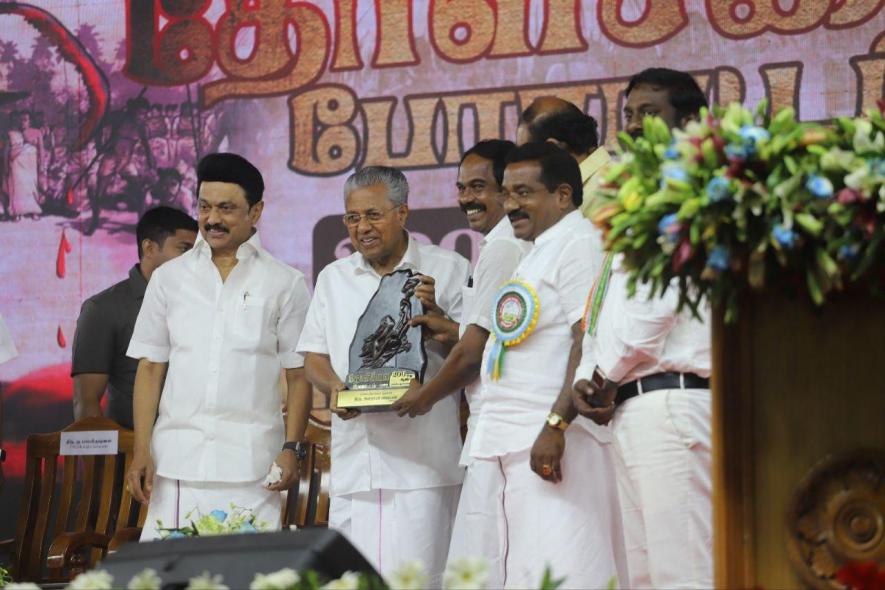
Mano Thangaraj, the minister for information technology in the Government of Tamil Nadu greeted the Chief Ministers of Tamil Nadu and Kerala. (Credit: J Jessin)
M K Stalin, in his address, said, “The Sanatana Dharma which was implemented in the Travancore state is the same one the BJP and RSS want to implement now. This dharma divides the people, while the Dravidian model considers all the people one and the same.”
The Tamil Nadu CM referred to the role of the Justice Party rule in ensuring social justice in terms of education and employment for all and bringing down the curtains on the ‘Devadasi’ practice.
The meeting became a show of strength of the Secular Progressive Alliance (SPA) led by the DMK in the state as leaders of the Congress, Viduthalai Chiruthaigal Katchi (VCK), Communist Party of India (CPI), Marumalarchi Dravida Munnetra Kazhagam (MDMK) and other smaller parties were present.
The leaders called upon the people to defeat the BJP aiming for another term at the Centre to save the nation's secular fabric and protect pluralism and federal principles.
“The BJP has failed in addressing the real issues plaguing the people and is facing their ire. To evade such questions from the people, the BJP is using religion as a cover and still has aspirations to win the 2024 elections, which cannot happen,” Pinarayi Vijayan said.
Get the latest reports & analysis with people's perspective on Protests, movements & deep analytical videos, discussions of the current affairs in your Telegram app. Subscribe to NewsClick's Telegram channel & get Real-Time updates on stories, as they get published on our website.









